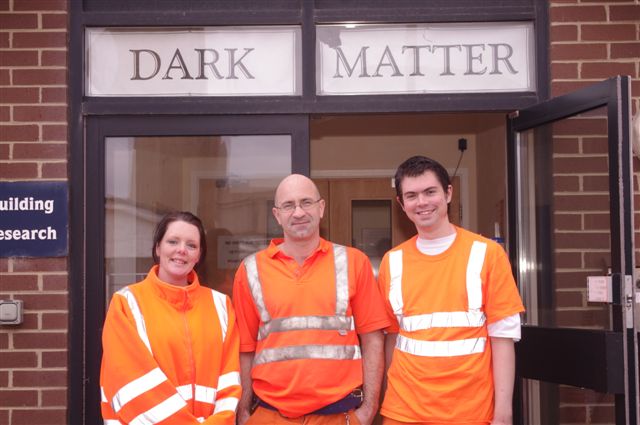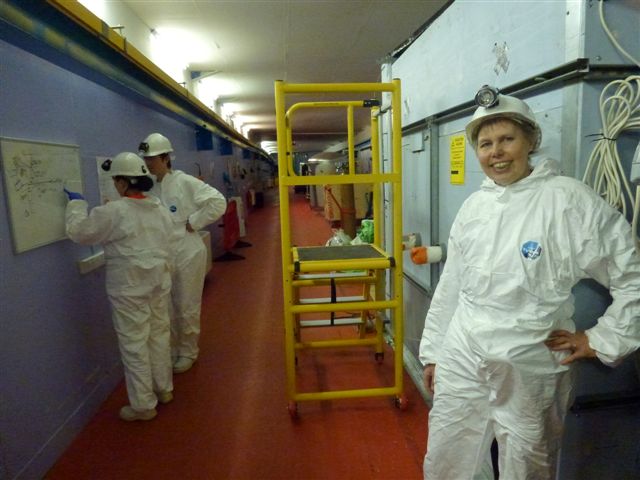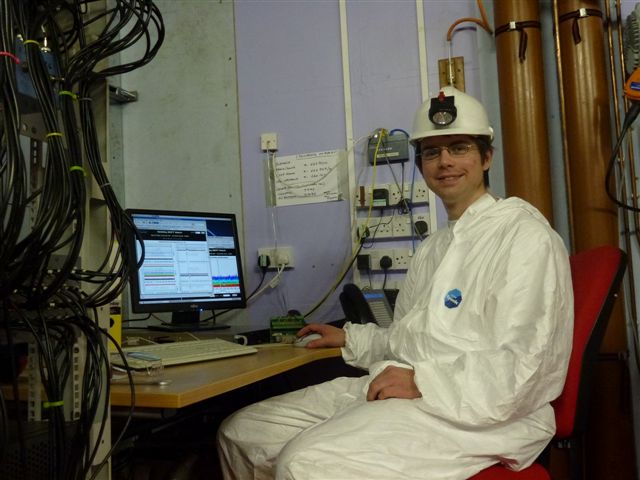The search for Dark Matter at Boulby Underground Laboratory
When I heard of an underground lab searching for Dark Matter, it sounded exciting but spooky. Dark Matter sounded like the stuff of science fiction: you can’t see it and you can’t touch it. So how do they know it’s there?
I was lucky enough to secure an invitation to the lab, from Dr Sean Paling, of the Science and Technology Research Council. Now I could ask the experts these questions. And here in this blog, I’ve tried to explain their answers.

Emma Meehan, Sean Paling and Daniel Walker prepare to go into the underground lab to search for Dark Matter
Dark Matter, explains researcher Dr Daniel Walker, is part of the Quantum world. And, he says, “The laws of nature we might experience in, say, picking up a cup, are very different at quantum level. So we’re using evidence to build a picture of the world beyond our own senses.”
His ‘evidence’ is the electronic signals that have served us well for things like TV, and computers. These machines, says Daniel, are built using early quantum research. Because these machines work, it’s believed that the theories they are built on are correct.
Getting to the lab, though, wasn’t a casual trip. I had to have a medical examination, then a lesson in how to use emergency equipment, should a problem arise underground.
I had to leave all battery powered items – including my watch – above ground, and change into orange overalls, boots and safety helmet, prior to the ride down the mine shaft.
It was a long ride. Boulby is Britain’s deepest mine – over ¾ of a mile deep, with tunnels running underneath the North Sea. Operated by Cleveland Potash Ltd, it produces potash, used for fertiliser, and rock salt, used to grit icy roads.
Once down the mine, we had a walk to the lab. The tunnels were wide and spacious, festooned with pipes and cables carrying services, and surprisingly quiet. Despite the breeze of the ventilation system, a fine dust lay over everything.
From time to time, a vehicle approached. It looked like something from the movies as the lights beamed through the dust and blinded us in the gloom. We couldn’t see the drivers, but whoever they were, they were courteous, driving slowly by, with a toot to make sure we were safe.
The lab, when we reached it, was a veritable rabbit warren of portable buildings – all painstakingly transported down the mine and erected.
Dark Matter Detectors have to be kept free from dust – not an easy task in a mine. So before we entered the lab, we had to cover our orange ‘walking in the mine’ overalls with white ‘anti-dust’ overalls. We changed shoes and hats, and passed through an ‘air shower’: a cubicle where nozzles blasted off the dust with clean air.
Apparently I looked so fetching in all the special clothing that Sean decided to take a photograph of me. So much for designer fashions! Here is a picture:
On the day I visited, the lab had three people in it: Sean, Dr Daniel Walker, a research associate from Sheffield University, and Emma Meehan, a technician.
Daniel visits the lab every week, and using the Internet, also monitors the Dark Matter detectors from Sheffield. At night, he hands over this task to partners in America.
Emma grew up near Boulby, and had always known about the lab. A self-confessed ‘geek’, she’d always had a yen to work in the lab – so when her chance came, she jumped at it. She says, “I was really lucky to get this job – it’s a fantastic opportunity.”
She adds, “This is not just science – this is ground breaking technology.”
The lab is down the mine to shelter it from cosmic rays, a rain of all sorts of sub-atomic particles that constantly falls on earth. They don’t do us any harm, but they interfere with the delicate instruments that the team uses to look for Dark Matter.
The Dark Matter people relish the excitement of working in this unique environment. Daniel says, “The miners are very friendly. Every time I see them in the lift, they ask if we’ve found anything yet. And they’ve been very helpful with moving our equipment down here.”
So what is Dark Matter, and why is it so hard to find?
The suggestion that Dark Matter exists came, says Daniel, from astronomy. Observers saw that galaxies weren’t behaving as expected from Isaac Newton’s description of gravity.
As famously shown by Newton’s falling apple, gravity pulls objects towards each other, depending on how big they are. But, says Sean, “Astronomers saw that there was more ‘pulling power’ than there should be from what they could see.”
It’s not just the odd bit of invisible ‘pulling power’. Sean says, “It is enough to suggest that over 80% of matter in the universe is missing.”
Because it was invisible, this mystery matter was dubbed ‘Dark Matter’.
So what is Dark Matter made of? The most popular theory, says Sean, is a particle called a WIMP – a Weakly Interacting Massive Particle.
Since you can’t see a WIMP, the team hopes to detect it by seeing its interaction with something they can see.
Sean explains that these interactions happen through the medium of forces. “In the whole of nature, we only know of four forces: Gravity, Electromagnetic force, the Weak force and the Strong force.”
They need one of these forces to act on the WIMP, thus causing an action that they can see.
Light is a form of electromagnetic force, and we experience it through our own personal detectors: eyes. X-rays and TV signals are also electromagnetic forces, and we detect these with electrical machines. But the WIMP is unaffected by the Electromagnetic Force, which means we can’t see it, or detect it with electricity or magnets.
The Strong force holds atoms in place and stops the centre of atoms (the nucleus) flying apart. But WIMPS are unaffected by the Strong Force, which, explains Sean: “Means WIMPS hardly ‘feel’ ordinary matter: they can pass through the earth easily, like it isn’t there.” This is why we can’t ‘touch’ a WIMP.
So those two forces are out. What about Gravity? It’s a force that we’re familiar with when we drop something. Sean says, “We think they ‘feel’ gravity – that’s why we think they exist in the first place. But gravity is weak on small objects. And the only other force they feel is the Weak force – which, by definition, is weak.”
The Weak force causes nuclear reactions, and release of some forms of radioactivity in nature , but, says Sean, “Most people don’t come across it in everyday life.”
But hopes of finding a WIMP rest on detecting one of these weak nuclear interactions.
Their latest WIMP detector is called DRIFT. It’s a box of a special gas, that, if hit by a WIMP, will become electrically charged, and so show up on an electronic detector. Here’s a picture of Daniel monitoring the results:
But the WIMP doesn’t just have to hit an atom of gas – it has to hit the atomic nucleus of an atom. And one of the things that makes the quantum world different to our experience is that, despite ordinary matter feeling solid, it’s mainly empty space.
In the quantum world, atoms are formed of a small nucleus orbited by electrons. The electrons form the ‘edge’ of the atom that we feel, but there’s a lot of space between them and the nucleus. Therefore, a large part of the atom is empty space, which is why WIMPS can pass so easily through solid matter.
The chances of a WIMP hitting an atomic nucleus are small. But, says Sean, “If we’re right, and WIMPS do exist, then once in a blue moon, one should hit the nucleus of an atom – even though the majority pass straight through us.”
“So we build sensitive detectors that can detect it when one of these hits.”
It does stretch the brain to consider all that stuff that you can’t see, can’t touch – but people who’ve thought about believe is likely to exist. I fell to considering the first people who suggested the world was a sphere. Everybody said they were wrong, because we walk on the earth and feel that it is flat. But now, people have gone into space, and we are familiar with the picture of the earth’s blue and green sphere.
Daniel is open about the possibilities. Although it would be exciting to find a WIMP, not finding one is not, however, failure. He explains, “It would still be an achievement if we ruled them out. We’ll know then that this theory isn’t right, and we have to think of a new one.”
Finding a WIMP, though, could bring glory. Sean says that credible evidence of a WIMP would be a potential Nobel Prize winner.
And the Boulby team is in a race to win this prize. A handful of other labs around the world are also looking for Dark Matter. What makes Boulby’s work unique, says Daniel, is that their detector also measures the direction of the WIMP. He explains, “The hit causes a ‘bounce’ effect like hitting a billiard ball, and from that we work out the direction.”
This is valuable, because, says Daniel, “The earth moves through a WIMP wind, and as the earth spins, the direction of this wind appears to change. What makes Boulby’s DRIFT detector special is that it can measure this direction.”
Finding a particle travelling in the right direction would add to the credibility that it was, in fact, a WIMP.
They monitor their detectors every hour – with American partners continuing the job overnight. And they see thousands of ‘hits’ on the detector. Despite their deep underground shelter, the equipment still senses a flurry of subatomic particles: mainly natural background radiation. Daniel says, “We record an event, on average, once a second.”
However, he says, each particle has its own ‘signature’. After discounting the signatures of particles they already know about, they’ve not yet seen a WIMP.
Emma says, “DRIFT is difficult to understand but once you get it, I really love the science. And I get to work with some of the best teachers in the world. When they tell of all the theories out there, it gets into an amazing discussion. Now I’m trying to come up with my own theory.”
Daniel cares about his work because, he says, “It’s contributing to the sum of human knowledge. And although it may seem ‘blue sky’, quantum physics in the past has led to developments that benefit the whole of society.”
He points out that researchers of the past had no idea what their work could be used for, but after discoveries were made, others turned them to practical use.
Emma says, “There are three of us regularly here at the mine, with a handful of other scientists at universities off-site and visiting occasionally. We’re not massive, but we’re mighty. The major thing is the funding: it gets granted for two or three years, then it will stop. So we live in hopes that it comes again.”
Sean comments, “Compared with some areas of science, we’re managing to do this in a low-cost way, because the mining company allows us to use their special environment. We’re grateful to Cleveland Potash Ltd for allowing us to work in their mine. Without that, it would be very difficult to do this research – but being here allows the UK to lead in this kind of science.”
So has our team found a WIMP yet? The answer is ‘not yet’ – but they are not disheartened. Sean says, “It’s like searching for your car keys: you look in the kitchen, the living room. But you’ve yet to look in the hall and the bedroom. We’ve not finished looking yet.”
You can read more about the lab at their website: http://www.hep.shef.ac.uk/research/dm/boulby/boulby.php


